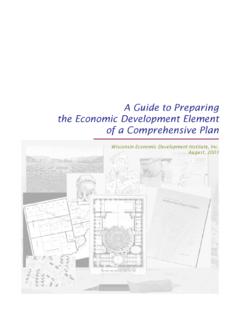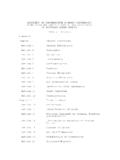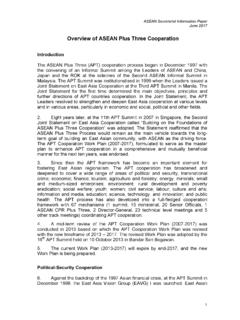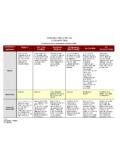Transcription of Chapter 1
1 OECD economic Outlook, Volume 2016 Issue 2 OECD 201613 Chapter 1 GENERAL ASSESSMENTOF THE MACROECONOMIC SITUATION1. GENERAL ASSESSMENT OF THE MACROECONOMIC SITUATIONOECD economic OUTLOOK, VOLUME 2016 ISSUE 2 OECD 2016 PRELIMINARY VERSION14 IntroductionFor the last five years the global economy has been in a low-growth trap, with growthdisappointingly low and stuck at around 3%. Persistent growth shortfalls have weighed onfuture output expectations and thereby reduced current spending and potential outputgrowth. Global trade and investment have been weak, limiting the advances in labourproductivity and wages that are required to support sustainable consumption , fiscal policies, both implemented and proposed, could, if effective, catalyseprivate economic activity and push the global economy to a modestly higher growth rate ofaround 3 per cent by 2018.
2 Exiting the low-growth trap depends on policy choices, as wellas on concerted and effective implementation. If, as assumed in the projections, theincoming US Administration implements a significant and effective fiscal initiative thatboosts domestic investment and consumption, global growth could increase by point in 2017 and percentage point in 2018. If the fiscal stimulus underwayin China continues to support demand, this could also bolster global growth by points per annum on average over 2017-18. A more robust fiscal easing thancurrently projected in many other advanced economies, including in the EU, would furthersupport domestic and global activity. OECD analysis of fiscal space indicates that the EUhas room for more concerted this backdrop of fiscal initiatives, progress on trade policy would help propelthe global economy out of the low-growth trap as well as support a revival of the other hand, worsening protectionism and the threat of trade retaliation could offsetmuch of the fiscal initiatives impact on domestic and global growth, leaving countries witha poorer fiscal position as well.
3 With pressures in labour and product markets building onlyslowly, inflation should remain modest in most economies, although resource pressurescould start to emerge in the United States. If expectations of medium and longer-termgrowth revive, thus allowing monetary policy to move toward a more neutral stance in theUnited States, it might help to ameliorate some existing distortions in financial markets,such as a lack of term and credit risk premia. However, the risk of a growing divergence inthe monetary policy stance in the major economies over the next two years could be a newsource of financial market tensions. New challenges have also arisen from the UK vote toleave the European Union, raising the prospect of an extended period of uncertainty untilthe future scope of trade relationships with the rest of the European Union becomes order to ensure the exit from the low-growth equilibrium, there is a need foreffective and collective policy efforts to support aggregate demand in the short term andraise potential growth in the longer term.
4 Towards these ends, accommodative monetarypolicy needs to be complemented by enhanced collective use of fiscal and more ambitiousstructural policies and avoidance of more widespread trade protectionism. Financialmarket distortions and prospects for greater volatility imply that there is no scope toexpand monetary easing beyond existing plans in the main advanced economies. On theother hand, countries should closely examine fiscal space with lower interest rates1. GENERAL ASSESSMENT OF THE MACROECONOMIC SITUATIONOECD economic OUTLOOK, VOLUME 2016 ISSUE 2 OECD 2016 PRELIMINARY VERSION15enabling countries to boost hard and soft infrastructure and other growth-enhancingspending for an average of four years while leaving debt-to-GDP ratios unchanged (seeChapter 2).
5 Collective action in this area, including reallocating public spending towardsmore growth-friendly items, would catalyse business investment and deliver additionaloutput gains from cross-country spillovers. Fiscal choices depend on structural policies,otherwise they will fail to strengthen productivity growth and labour utilisation and willundermine debt sustainability. Given the dramatic slowdown in trade, reversingprotectionist measures since the crisis and further expanding the scope for internationaltrade, coupled with measures to better share the gains from trade, are key collectivestructural policy priorities. A bold and comprehensive use of monetary, fiscal andstructural measures should raise growth expectations and reduce risk perceptions, andthereby put the global economy on a sustainable higher-growth recovery could gain steam depending on policy choicesProspects for sub-par global growth persist despite the low-interest rate environment(Figure ), reflecting poor underlying supply-side developments, modest aggregatedemand and diminished reform efforts.
6 Despite an upturn in the third quarter of 2016,global GDP growth is estimated to have again been around 3% this year, over percentagepoint weaker than the average in the two decades prior to the crisis. In the absence of actionto remedy this persistent shortfall, it will be increasingly difficult for governments to meetall of their implicit future commitments to society, or even meet current expectations fortheir citizens. While there are signs that output growth has now started to edge up in theemerging and developing economies after a prolonged slowdown, helped by the near-termeffects of policy support in China and easing recessions in many commodity producers, theadvanced economies have yet to collectively gain much additional GDP growth is set to riseYear-on-year percentage changesNote:GDP measured using purchasing power With growth in Ireland in 2015 computed using gross value added at constant prices excluding foreign-owned multinationalenterprise dominated :OECD economic Outlook 100 2 WorldOECD non-OECD1.
7 GENERAL ASSESSMENT OF THE MACROECONOMIC SITUATIONOECD economic OUTLOOK, VOLUME 2016 ISSUE 2 OECD 2016 PRELIMINARY VERSION16 News-based measures of policy uncertainty remain elevated in a number of countries,and at the global level (Figure ). This adds to downside risks, with likely negative effectson activity if it persists. Despite this, equity market turbulence has eased after sharp initialreactions to the results of the US election and UK referendum, although bond marketvolatility has risen. Government bond yields have turned up from historic lows in manyeconomies, helped by higher market expectations of future inflation and hence the futurepace of policy interest rate rises in the United growth could gain some steam through the next two years, albeit only toaround 3 per cent by 2018 and under the assumption of a more supportive fiscal stancein the United States, with associated demand spillovers to other economies (Table ).
8 Ifthese changes in the United States and the estimated impact of projected fiscal easing inChina and the euro area fail to materialise, global GDP growth would be percentage point weaker than projected in 2017 and percentage point weakerin 2018 (Box and Figure ). Even weaker outcomes would result if restrictive trademeasures were to be put in place, but the implementation of trade facilitation measureswould boost growth (Box ).Figure policy uncertainty remains elevated in a number of economiesPolicy uncertainty index normalised over 2011-2015, 3-month moving averageNote:The emerging market economies measure is a PPP weighted average of news-based policy uncertainty in China, India, Brazil andRussia.
9 The estimates for the United States and the United Kingdom in November are based on daily data available up to November ; and OECD 2 Global201120122013201420152016-2-10123 Emerging market economies201120122013201420152016-2-1012 3 United States201120122013201420152016-20246810 United Kingdom1. GENERAL ASSESSMENT OF THE MACROECONOMIC SITUATIONOECD economic OUTLOOK, VOLUME 2016 ISSUE 2 OECD 2016 PRELIMINARY VERSION17 Table global recovery could gain some steam1 2 area, unless noted otherwiseAverage 2016201720182004-20132014 2015 2016 2017 2018 Q4Q4Q4 Real GDP growth1 OECD2.
10 United Euro Output Unemployment Inflation1, Fiscal World real trade 1.














